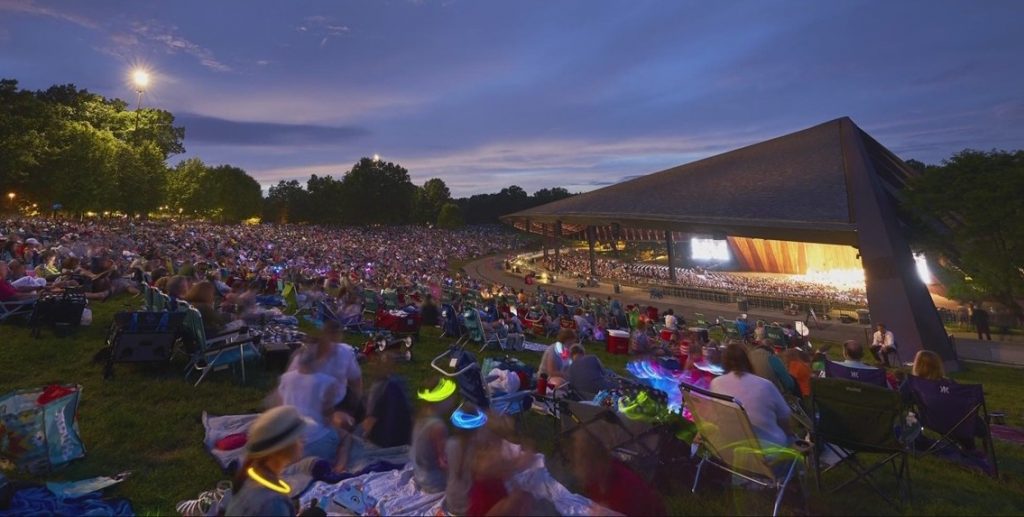by Peter Feher
This article was originally published on cleveland.com

Hundreds of singers and instrumentalists are joining forces for “The Lord of the Rings: The Return of the King” live in concert, the eagerly awaited conclusion to a trilogy that began for Northeast Ohio audiences in 2022.
Over three summers, the Cleveland Orchestra will have presented each film in director Peter Jackson’s monumental fantasy series — the ensemble playing Howard Shore’s sweeping symphonic scores as the story of Frodo and Sam, the One Ring, and the fate of Middle-earth unfolds on screens around the Blossom Pavilion.
The stakes couldn’t be higher for the third and final episode, but all things good prevailed in the Orchestra’s performance on Friday, Aug. 2, with conductor Ludwig Wicki, a fixture of “Lord of the Rings” concerts worldwide, returning to Blossom for this program.
There are two more performances of “The Return of the King” this weekend, Saturday, Aug. 3 and Sunday, Aug. 4.
Everything seems to be on a bigger scale for the concluding installment of the trilogy. Multiple major battles are waged and won, man-made structures appear to tower over the natural scenery, and Shore’s music approaches operatic proportions. The Orchestra’s contributions are cranked up, and the singers — drawn from the Blossom Festival Chorus, the Cleveland Orchestra Children’s Chorus, and several other area choirs — number some 130 strong.
But just as often the film achieves magnificent ends through simpler means. Shore crafted many of his best compositions from basic building blocks, similar to the way that Jackson’s team created stunning visuals by starting with miniature set models before adding computer-generated imagery.
Structuring the score through a series of leitmotifs — short, recurring musical themes attached to specific people, objects, and ideas — was hardly a unique decision given the source material. The world of J.R.R. Tolkien draws on some of the same mythology as Richard Wagner’s opera cycle, “The Ring of the Nibelung.” Although Tolkien denied the connection, Shore alludes to Wagner’s operas by deploying one of the German composer’s favorite techniques.
However, Wagnerian leitmotif isn’t the only tool that Shore adopts in defining the musical landscape of Middle-earth. Certain sections of the score border on the realm of role-playing, from the Celtic-inflected tunes that accompany the hobbits to the quasi-medieval fanfare that announces the riders of Rohan.
The stand-alone songs featured in the film have a folk feel as well. There’s a haunting melody sung in the film by Billy Boyd’s character, Pippin, as well an end-credits number, “Into the West,” first recorded by Annie Lennox and performed live at Blossom by the versatile soprano Kaitlyn Lusk. Lusk also sang several special solos in Tolkien’s invented Elvish language throughout the evening.
At the other end of the movie-music spectrum, Shore knows when just pure underscoring is needed, the soundtrack tending in the direction of a horror film for those scenes. Amid the suspense generated by shivering strings and percussion effects, it’s perhaps surprising to realize that silence serves a crucial function here. The score cuts out at pivotal points, such as when two armies are about to collide in battle.
The fight sequences are finely-tuned soundscapes, with clashing swords, soaring orchestral themes, and shouted dialogue all somehow brought into striking balance. Occasionally, a single voice rises above the fray. Singing with sweet seriousness on Friday, child soloist Hollie Tennant promised that peace will be far from a passing moment.
Peter Feher is managing editor of San Francisco Classical Voice, one of classical music’s leading online publications, and a correspondent for the website ClevelandClassical.com. He lives in Cleveland.
Published on ClevelandClassical.com August 9, 2024
Click here for a printable copy of this article



